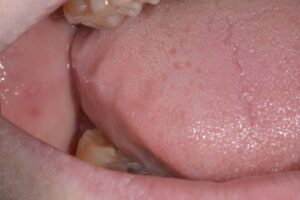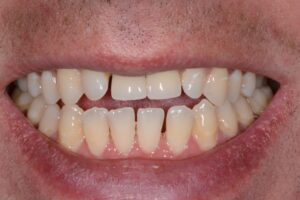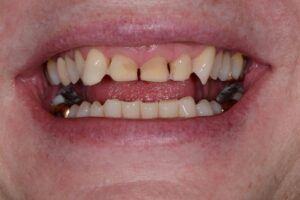Breathing is something we don’t often think about, yet it’s an essential body function. We can control our breathing to some extent when we’re awake, but not when we’re asleep; our inner brain takes over this role. Our sleeping hours are when breathing problems can seriously affect our teeth. There are a host of tooth-related symptoms that can be indicators of an airway problem. An airway or breathing problem is any constriction of the nasal passages and/or the nasopharynx, (the passageway between the back of the mouth and the throat). The following is a list of tooth problems and how they may be caused by a breathing problem.
Worn Teeth
When we can’t breathe well through our nose—which is how we’re meant to breathe—we resort to breathing through our mouth. Have you ever had a bad cold with a swollen, runny nose you were unable to breathe through? When you woke up in the morning, you may not have felt well-rested and your mouth and throat were probably dry. The reason is that when we mouth-breathe, the air rushing through our mouth causes it to dry out. You don’t feel well-rested because mouth breathing didn’t allow you to get the proper amount of deep sleep necessary for normal body and brain repair. Any sort of constriction of the nasal passages causes us to mouth-breathe, and this leads to tooth wear.
How? Worn teeth are a sign that the teeth are being bruxed. Bruxing is the habit of clenching the teeth together and grinding them against each other. This action causes the teeth to wear down. But what does bruxing have to do with breathing? When the tongue falls back into the throat as we are sleeping, it partially closes off the airway, making it harder to breathe. In addition, the muscles of the throat relax when we sleep, allowing the airway to become even more restricted. Sleep studies show sleep bruxism increases airway patency by increasing the muscle tone of the throat. In other words, obstruction of the airway by the tongue or the throat tissues stimulates us to clench the teeth as an unconscious attempt to relieve the airway. Thus, the teeth become worn down because bruxing helps us breathe better. If you’d like to learn more about this and see photos of what a bruxer’s teeth look like, click here.

Worn teeth
Photo: Dr. Eric McRory
A Scalloped Tongue
Scalloping of the tongue happens when forward pressure of the tongue against the teeth creates an imprint of the teeth onto the tongue. Forward tongue pressure is often an unconscious response to the tongue restricting the airway. Normally, the tongue doesn’t impinge on the airway, but if there is inadequate room in the mouth for the tongue, the tongue gets pushed into the airway. There are many reasons why there may be inadequate room for the tongue in the mouth. One of the most common reasons is improper development of the jaws. For instance, when the jawbones are developing during infancy, the tongue may be tethered down by tissue (a “tongue-tie”) and can’t properly stimulate the growth of the upper jaw (maxilla). The result is a narrow maxilla that doesn’t provide adequate volume to house the tongue; think of the vault in the maxilla as the garage for the tongue. In the case of a narrow maxilla with a high vault, the tongue is forced down and back into the airway. The classic facial appearance with this type of improper maxillary growth is the “long-narrow face syndrome,” typically accompanied by asthma, allergies, and a host of other problems, such as ADHD. (Picture the movie actor who plays Napoleon Dynamite). Our unconscious reaction to this tongue-caused constriction of the airway is to push the tongue forward against the teeth, creating the scalloped imprint of the teeth onto the tongue. Technically, this isn’t an example of how teeth are affected by breathing problems, but it helps to explain the next example, which does pertain to the teeth.

Scalloped tongue
Photo: Dr. Eric McRory
With a normal bite, all of the teeth touch simultaneously when the mouth is closed, including the front teeth. When the tongue is postured forward, due to its impinging on the airway, the tongue can actually start pushing the teeth forward. This creates spaces between the teeth as they tip forward. If the teeth move forward enough, there will no longer be any contact between the edges of the lower front teeth and the backs of upper front teeth. This “uncoupling” of the upper and lower front teeth is referred to as an “anterior open bite.”

Open bite
Photo: Dr. Eric McRory
An Increased Incidence of Cavities (tooth decay)
Tooth decay is caused by certain species of acid-producing bacteria that live in the mouth. These bacteria thrive in low pH (acidic) environment. Our mouths become much more acidic when dry. Saliva is a buffering agent, meaning it helps keep the pH balanced and fairly neutral. Dry mouth can have many causes, such as certain medications or radiation treatment, but is often caused by mouth breathing. This makes perfect sense: when our mouths are open, we evaporate the water in the saliva as air passes in and out. The dry condition favors bacterial growth, which leads to acid production, which then creates tooth decay. On the other hand, when we breathe through the nose, there is no need to open the mouth, thus the drying effect from air can’t take place, and the chance of tooth decay is reduced.
Red Irritated Gums Around the Teeth
Once again, gums are not a tooth problem, but the same processes are at play in this example. Red irritated gums (gingivitis) can be caused by many things but are typically caused by bacterial plaque. As in the example above, the growth of bacteria causing gingivitis is enhanced by a dry (acidic) environment. Therefore, mouth breathing contributes to gingivitis. In these cases, we usually see the gingivitis more around the front teeth than the back teeth; this is because the drying effect of mouth breathing is more profound in that area of the mouth.
Tooth Erosion
Tooth erosion is a chemical process whereby acids in the mouth dissolve the mineral structure of the teeth. Although this acid erosion can have an extrinsic source—such as carbonated beverages or eating acidic foods—it can also have an intrinsic source. Gastric fluids, or “stomach acid,” when regurgitated into the oral cavity, is an intrinsic source of acid. Stomach acid, as most people know from the experience of vomiting, is highly acidic and leaves a rough surface on our tooth enamel on contact. Studies show a high incidence of gastroesophageal reflux disease (GERD) in those who have problems breathing while they sleep, (“sleep-disordered breathing”). When we have trouble breathing while we sleep, we tend to regurgitate stomach acid. This acid sits in our mouth and erodes the surface of our teeth. Typically, the chewing surfaces are affected more than the other surfaces of the teeth, and there tends to be one side of the mouth more affected than the other if the person is a side-sleeper. The side of the mouth affected by acid erosion is the same side the person favors sleeping on, due to gravity pooling the acid to one side or the other. The combination of sleep bruxism, sleep-disturbed breathing, and GERD are known as the “Bruxing Triad,” and is a typical array of signs seen in individuals with breathing problems. Learn more here.

Severe erosion
Photo: Dr. Eric McRory
This is not an exhaustive list of tooth problems that are associated with breathing problems, but it hopefully gives insight into how important the simple act of breathing is and how disturbed breathing can affect other parts of our body, including our teeth.
If you think you may have a breathing problem, please contact us today.

Leave A Comment
You must be logged in to post a comment.